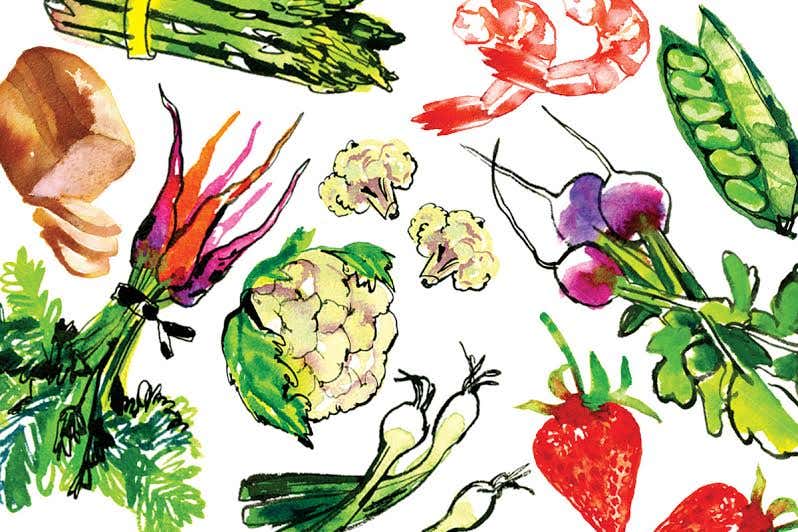
It doesn't take long for visitors to the Cape Ann peninsula in northern Massachusetts to figure out what the local specialty is. Here, on a stretch of land every bit as scenic and charming as that of Cape Cod to the southeast, clam shacks are more abundant than fast-food joints. But not just any clams are on offer: On Cape Ann, soft-shells (also called long-necks, steamers, or just mud clams) are king. These clams (Mya arenaria), easily identifiable by the long, rubbery siphons, or necks, that protrude from their thin, brittle, elongated shells, are foundall along the East Coast, from Maine to North Carolina, and as far afield as Britain and France. Most clam lovers, though, myself included, are partial to the exceptionally sweet and tender ones harvested from the mud flats off Ipswich, on the edge of Cape Ann. One taste of these particular Ipswich clams makes it very clear that not all soft-shells are created equal.
And why are Ipswiches so good? For at least three reasons, apparently: The water in the area has a high level of salt, which affects the flavor of the clams, and of plankton, which helps them grow quickly; and state law requires that the mollusks be hand-harvested, so that they're not damaged by commercial dredging. It's no wonder, then, that sometime in the 1940s, Ipswich became the hub of the local clam-processing industry—a windfall that made the town synonymous with soft-shells. But one unfortunate consequence of its fame is that today many soft-shells not actually harvested on the Cape are passed off as Ipswich clams. If you want real ''native''Ipswiches, you have to ask for them as such.
Like all soft-shells, true Ipswiches are best fried or steamed, which is precisely how the shacks on Cape Ann prepare them. I've been eating soft-shells here for three decades and can recommend the White Cap in Ipswich itself, the Cupboard in Gloucester, and the Red Barrel, the Hearthside, and Woodman's—which claims to have invented the fried clam in 1916—in Essex. But my favorite is Essex's Village Restaurant. There is something special about the clams here, particularly the fried ones; the flavor of the sea just seems to shine through their light, crunchy coating. When I asked Village co-owner Kevin Ricci for his secret, he replied, ''I try to buy my clams from Ernie Smith. He always does a good job.''
Fortunately, Smith, who comes from nearby Gloucester and has been harvesting soft-shells professionally for most of his life (he is 64), agrees to let me spend a day digging with him and his uncle, Stanley Roberts. We meet early one midsummer morning on a 15-acre sandbar nicknamed the Spit, in the middle of Cape Ann's Essex Bay—which feeds into Ipswich Bay. It's a gorgeous day, hot and clear. There are 20 people out, all working in pairs, each team separated by about a hundred yards. Everyone is hunched over, using short-handled rakes with long, curved prongs to cut through the sand, and wearing hats to protect them from the relentless sun. It's almost like a scene out of a Millet painting.
Since clams can be harvested from the sandbar only in the hours just before and after the tide goes out, Smith insists that we work while we talk. Theoretically, there's nothing to clamming: You pick a spot—which isn't too difficult considering these are ''piss''clams, unwittingly revealing their location by spurting water from under the sand—then you plant your feet wider than your shoulders, bend over, and start digging. The problem, at least for novices like me, is that you have to dig very carefully around and under the clams to avoid breaking their fragile shells with the rake or your fingers. I'm happy to have gathered a dozen in about ten minutes; then I realize that I can eat _three _dozen in less time. Meanwhile, Smith and Roberts, who have a hundred years of clamming experience between them, have filled half a milk crate—each.
Apart from a 20-year period in the construction business, Smith has always made his living by clamming. It isn't an easy way to support a family—the intake can be very meager at times—but it's a job he clearly enjoys. He's on the water most of the year, even after the weather turns so cold that others head for indoor work. But he knows his days of professional digging are numbered: ''The next time the clams peter out,'' he confides, not bothering to stand up, sweat dripping off his red face, ''I'll start collecting Social Security.''Smith estimates that there are a dozen or more full-time clammers on Cape Ann, but says that number jumps to ''a couple of hundred''who drop everything to dig in the summer when the yield and the selling price are higher.
After about four hours of grueling work that leaves me with a raging backache, we retreat to Smith's house, where he and his live-in father-in-law, Harold Malonson, slowly and steadily shuck half of our four bushels of clams (the rest will be sold whole). I pop a few of the quivering bodies into my mouth: They're as salty as the briniest oyster, fine-textured, and pretty sandy (thanks in part to their siphon, which prevents the shells from closing completely). I decide that I prefer these, unlike most other mollusks, cooked.
Back at The Village Restaurant, Ricci admires the uniformly shaped whole clams and remarks that Smith's always look like they came from a cookie cutter. I'm happy to talk about clams, and even happier to eat them, but what I'm really interested in right now is a lesson in frying, Massachusetts-style. (In Maine, where soft-shells are equally popular, locals prefer to coat the clams in batter, but here a dry coating is standard.) Ricci obliges, taking a handful of freshly shucked clams, rinsing them in milk, dredging them in a mixture of extra-fine cornmeal and ''a few other things''—the exact recipe is a secret, of course—then plops them into a vat of hot lard until they just turn golden brown. Many of the Cape's clam shacks have stuck with this traditional frying medium, defying the health police. ''Lard tastes the best and doesn't give you indigestion,''Ricci maintains.
As soon as they're ready, I dig into the fried beauties. Ricci smiles at my enthusiasm but tells me he prefers his clams steamed. I can accept that. The bottom line is, however you like them, no clam lover should pass through Cape Ann without sampling a plateful of the best soft-shells in the universe.
Keep Reading
Continue to Next Story










